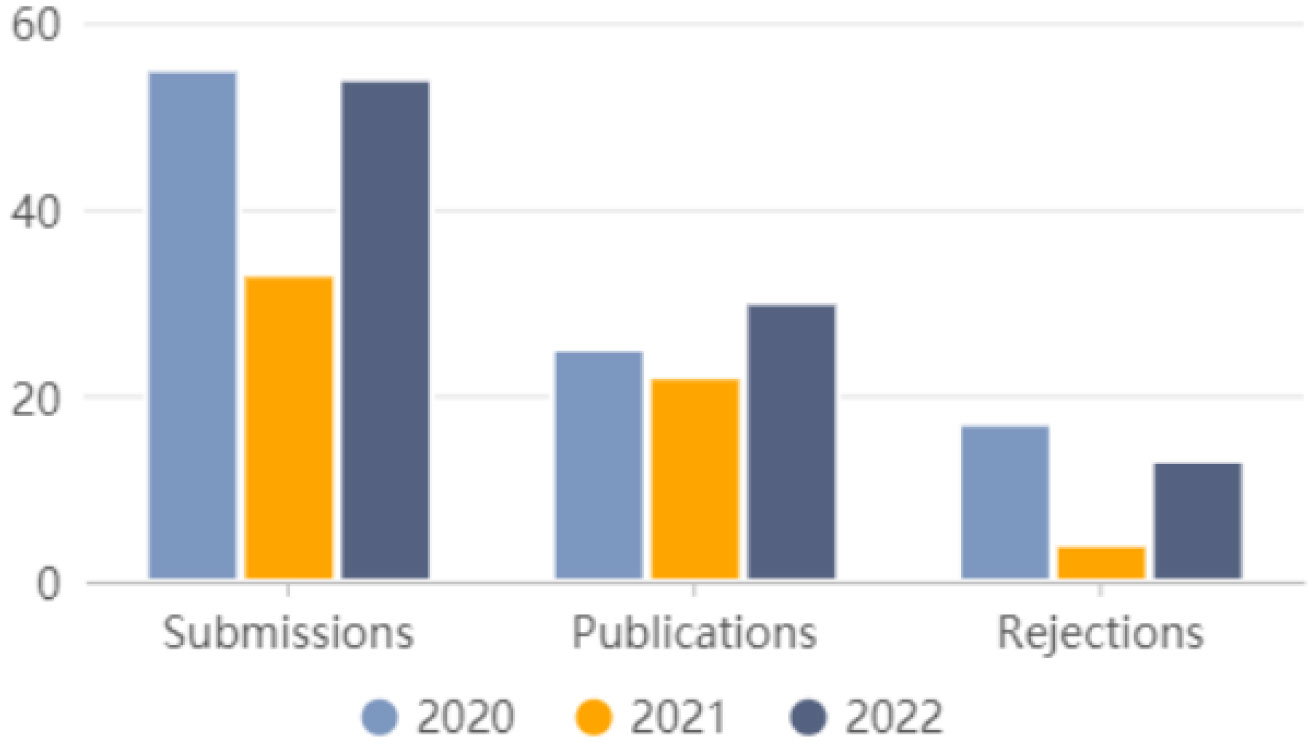1.
Journal summary
Now we have stepped into 2023, at the beginning of the new year and together with the Editorial Office of AIMS Bioengineering, I wish to testify my sincere gratitude to all authors, members of the editorial board and reviewers, thanking everyone for their contribution to AIMS Bioengineering in 2022, now we hope we could cooperate with you more this year.
During the 2022, we had 54 submissions, 30 published papers. Of these, 21 were research articles. Authors were most often from France, Spain, Britain, Japan, Iran, Pakistan and other countries. The percent of the international collaborations is rising.
A total of three special issues were issued in 2022, and it is hoped that these three special issues will attract more contributions from authors in 2023. The special issue published, “Microtissues in cancer modeling” has published five articles in 2022. AIMS Bioengineering invited four experts to join our editorial board in 2022. To sum up, AIMS Bioengineering didn't invite many editorial boards and issue many special issues in 2022. The focus of this year's work was on manuscripts and manuscript processing.
For the next year 2023, I hope we can increase the number of high quality submissions to this journal, while maintaining a rigorous review process. We also have a number of actions planned which we hope will enable further development to strengthen the presence, quality and sustainability of our journal. For example, issuance of more popular special issues, renewal of the Editorial Board and reduction of processing time. We will be seeking the support of the Editorial Board members to make this plan a success.
I would like to end this report by thanking all the members of the journal's Editorial Team and Board. The continued growth seen in 2022 was due to your hard work and I look forward to working with you to further build the strength and reputation of our journal in 2023.
The AIMS Bioengineering Editorial Office
Springfield, MO 65801-2604, USA
2.
Editorial development
2.1. Manuscript statistics
The submissions of our AIMS Bioengineering journal in 2022 uptick slightly.
Submission: 54
Online: 30
Rejection(After review): 13
Reject rate: 24%
Median Publication time (from submission to online): 63.5 days
In addition, our manuscript median processing time from submission to publish online in 2022 was 63.5 days, more than 10 days longer than the 54.5 days in 2021 and 50 days in 2020. The improved processing time is reflected in the increased processing time for English editing and typesetting of manuscripts since manuscripts were accepted.
2.2. Author distribution
Author country of origin distribution is shown below. It is pleasing to see so many countries represented among our authors. The number of published articles in each country among the 30 published online in 2022.
2.3. Article type
The table below lists the article type of published articles.
2.4. Article metrics
2.5. Special issue completed with the most papers
An important part of our strategy has been preparation of special issues. We encourage Editorial Board members to suggest potential topics and to act as editors of special issues.
Special Issue:
Bioengineering applied to Covid-19 pandemic: from bench to bedside
Special issue editor: Professor Rogério Leone Buchaim
http://www.aimspress.com/aimsboa/article/5647/special-articles
2.6. Editorial Board members
AIMS Bioengineering has 49 Editorial Board members, 4 of which joined in 2022. Importantly, we thank all Editorial Board members for their hard work throughout the year, and it is noted that many Editorial Board members made significant contributions to our journal. We will continue to renew Editorial Board in 2023, removal of members who have become inactive.
2.7. Summary & plan
2.7.1. Summary
In 2022, our journal developed smoothly. We have received more than 50 submissions and published 30 papers in 2022.
2.7.2. Plan for 2023
In 2023, AIMS Bioengineering will also have an IF. It is hoped that the overall level of bioengineering will be improved through this opportunity. Increase influence by soliciting and advertising high quality articles and special issues (topics). We seek to be indexed by more databases in 2023.
In order to distribute the knowledge, quality science and to enhance the scope of our newly launched journal we need support from eminent professionals. With this in mind, our first action for 2023 is to continue updating the Editorial Board. This renewal has two parts: (1) invitation of leading scholars in the field of Bioengineering to join the Board; and (2) removal of members who have become inactive.
Our second action for 2023 is to invite high reputation and professional authors to submit manuscript for our journal. We will try to invite more high-quality articles (Research and review), especially the review. And we plan to increase the proportion of articles from developed countries.
The third action is to edit more popular special issues associated with hot topics on Bioengineering around the world. This will attract more submissions from authors studying Bioengineering. Increase influence by soliciting and advertising high quality articles and special issues (topics).
The fourth action is to improve the journal influence. We strive to have our journals indexed by all top databases, including web of science, Scopus, Pubmed, etc. We seek to be indexed in Pubmed in 2023. We also strive to maximize exposure to high-quality articles in a variety of ways in order to provide good science and knowledge.










 DownLoad:
DownLoad:



